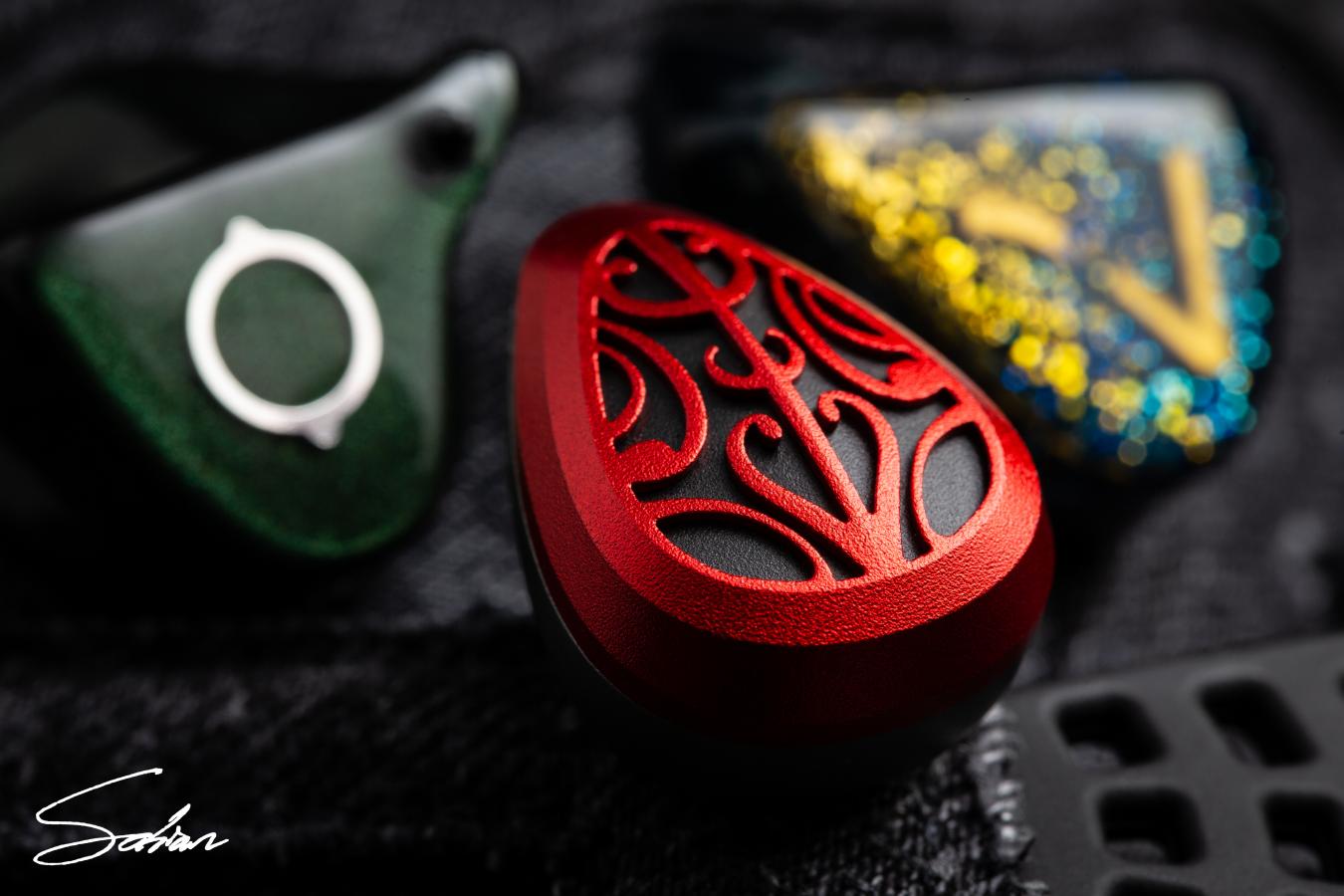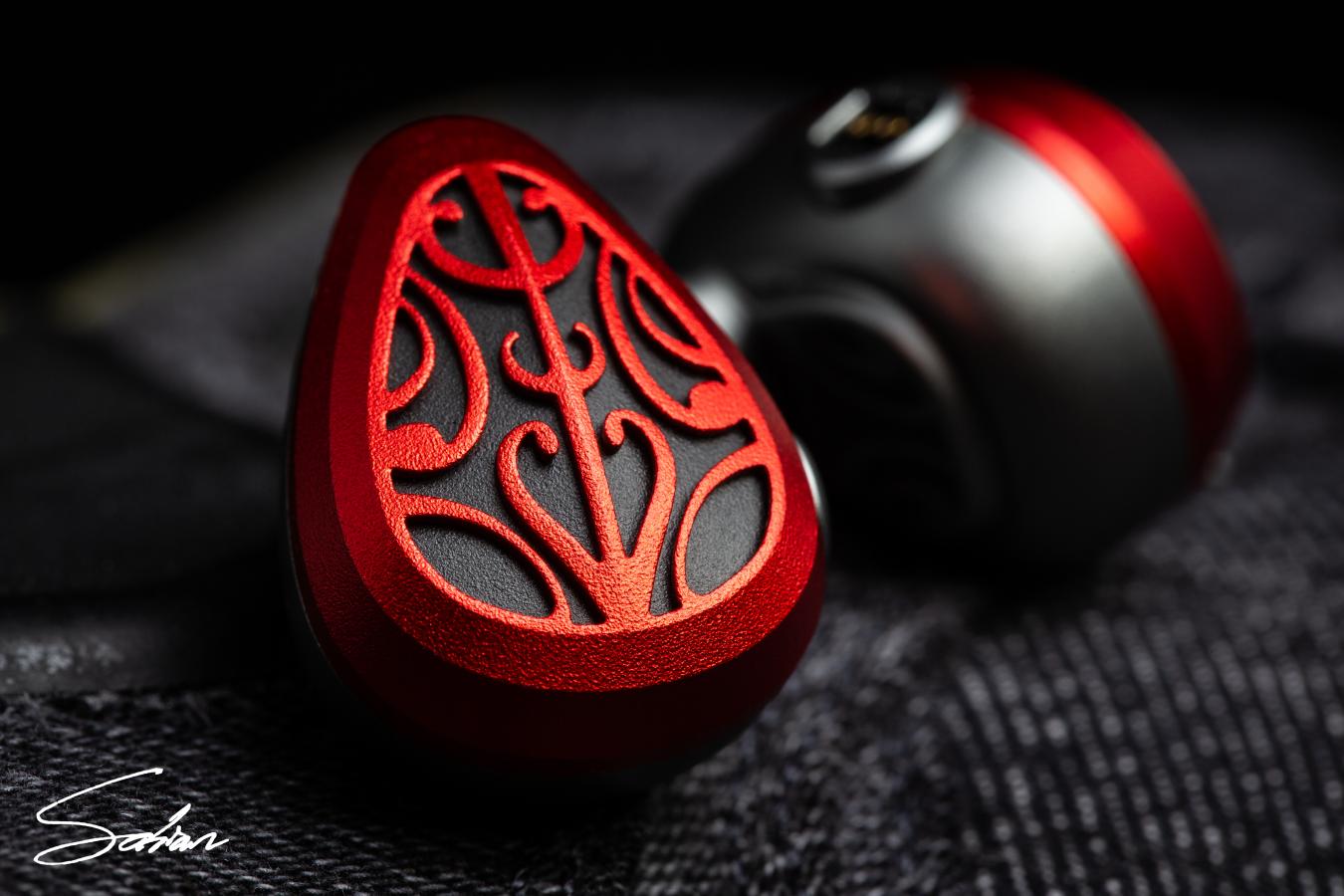Select Comparisons
Custom Art FIBAE 7 (1100 EUR)
Both the FIBAE 7 and Gáe Bolg err on the warmer side of neutral; showcasing balance throughout much of the frequency range, and ending with a more reserved high-treble. They’re also similar in that they add size and presence to their mids, but with two entirely different approaches. The FIBAE 7 tops its 1-2kHz rise with a 3kHz peak, which gives it its saturation and roundedness. Instruments like horns sound like they’re projecting close to you; upfront and direct. The Gáe Bolg, on the other hand, employs an upper-midrange dip, which, again, takes away this forcefulness and results in vocals that are full and chesty, but laid-back at the same time. Where they gain their energy, then, is in the lower- and mid-treble, where the FIBAE 7 opts to dip instead. With percussion, you get a bit more crackle and snap out of the Gáe Bolg, while the FIBAE 7’s delivery is a bit more diffuse. Keys and guitars sound brighter too. In terms of extension, though, I find both monitors fare well. Both introduce sufficient amounts of air into their respective stages, and lend headroom for clean layering too.
On the opposite end of the spectrum, the FIBAE 7 and Gáe Bolg aren’t dissimilar in presence and positioning. Both sport lows that straddle neutral, but have the capacity to elevate beyond it when called for. This Gáe Bolg has a hair more sub-bass, which gives it bottom a more solid, slightly more physical foundation. The FIBAE 7’s is smoother, warmer and more expansive by comparison. It introduces a hair more warmth into its image. But, it could also be because it’s a CIEM, while the Gáe Bolg’s a universal. I’ve noticed UIEMs tend to choke and shrink the lows a bit compared to their custom versions. But, this won’t matter until MMR decides to release a custom Gáe Bolg. Spatially, I find the FIBAE 7’s image larger overall. And, its more linear tonality allows for a more even spread of instruments as well. Still, the Gáe Bolg’s tighter notes hand it an edge in accuracy and precision. Finally, in terms of detailing, this Gáe Bolg sharper, more prominent transients lend it stronger clarity or cut. But, lower down, this FIBAE 7 has better presence and texture. So, it’ll depend on your priorities.

Lime Ears Aether R (1200 EUR)
Compared to the Aether R, MMR’s Gáe Bolg isn’t as vibrant or bright of an in-ear. The former’s peaks along the high-mids and mid-treble give higher-pitched instruments expressiveness and punch, while the Gáe Bolg, again, is tuned a bit more relaxed in these regions. Horns will have a more brass-y sound to them, and hi-hats sport a more metallic tick to them as well. On the Jacob Mann Big Band’s Baby Carrots, for example, the Aether R puts the trumpets front and centre, while the Gáe Bolg highlights the saxophones more. Similarly, on Tori Kelly’s Masterpiece, this Aether R reproduces her voice with a brighter, throatier profile, while the Gáe Bolg’s delivery is chestier, warmer, more intimate and more enveloping. This too is courtesy of the Gáe Bolg’s fuller, larger-sounding upper-bass and lower-midrange. It provides size and meatiness to its instruments, while the Aether R’s are a tad more distant and less substantial by comparison. This also has spatial effects, where the Gáe Bolg’s stage feels a tad more crowded, though organised all the same, and the Aether R’s is a touch airier.
As far as their extremes go, up top, both in-ears exhibit similar degrees of bite with snare hits and string plucks. Though, because of where their respective peaks are positioned, they’ve got very different textures. Again, the Aether R has crisp, bright, more metallic transients with an 8kHz peak, while the Gáe Bolg has smoother, more bodied highs, courtesy of the 5-6kHz and 10kHz peaks. The latter may get as energetic with some material, but it won’t ever cut as much as this Aether R’s will. On John Mayer’s Edge of Desire, for example, both monitors get pretty shrill on his sibilants, but the R’s delivery is brighter, while the Gáe Bolg’s has a warmer tone to it. I find this helps the latter perform particularly well with music that includes trashier hi-hats, or more organic-sounding drums in general. Whereas, the Aether R is capable of more cut for a genre like pop. Then, down low, the Gáe Bolg’s got the far meatier, longer-decaying bottom-end to my ears. It’s got more personality and texture to it, while the Aether R’s is tighter and more functional; a tad more clinical-sounding, if anything.

FiR Audio M3 (USD 1199)
The differences between the Gáe Bolg and the M3 are pretty clear at first listen. The latter is tighter and crisper-sounding with more contrast between extremes, while the former has more meat to its bones. That first stems from the M3’s sub-bass bias, which slopes down into its fairly dipped low-mids. This means its bass notes are tighter, further removed from its midrange. And, they’re darker as well, which, again, provides a stronger contrast against its bright, crisp high-end. The Gáe Bolg lets its low-end a bit looser by comparison, melding it to the midrange for a more organic tone and introducing a tad more warmth to its image as well. Speaking of the treble, the M3 has more of it, and it’s been exaggerated for extra fun too. It has a 5-7kHz rise to sharpen transients, particularly noticeable with how crisply cymbals and hi-hats bite. And, a lifted high-treble gives it an airier stage as well. Though, because of that, the Gáe Bolg does have the more linear, more natural-sounding highs with a more realistic timbre to rides and keys. It’s all just delivered in a smoother, muter manner.
In technique, though, I feel this Gáe Bolg edges out the M3 in most respects. Though neither IEM has the most expansive of stages, the Gáe Bolg is the stronger organiser of the two by a fair margin. It positions notes with greater accuracy, and its stereo spread is wider too. Despite this Gáe Bolg’s fatter, more intimate notes, it also renders depth more realistically. Whereas, all this M3’s instruments stand more-or-less in single file. When it comes to detailing, you’ll hear crisper, tighter notes from the M3. But, to me, this Gáe Bolg has the more prominent texture, especially in its low-mids. Instruments are more fleshed-out, more three-dimensional, and they’ve got more weight to them too. The one exception would probably be the bass, where the M3’s diaphragm lends a lot of genuine rumble, while the Gáe Bolg’s isn’t necessarily as tactile. So, tonal differences aside, I feel resolution, texturing and stage expansion are all traits the Gáe Bolg ultimately has more of.
Verdict
With this 2020 Gáe Bolg, MMR have crafted a daily carry that doesn’t compromise character or personality for versatility. It’s unapologetically bold, intimate and meaty. Yet, through its linearity and technique, it works comfortably with a sea of genres nevertheless. The bass, while not skull-rattling, soars through depth, musicality and decay. The mids are steeped in gutsiness, warmth and size, yet airy and resolving all the same. And, its highs, while tapered, has both articulation and naturalness in tone too. That’s not to mention its exquisitely-made, thoughtfully-designed and pristinely-finished chassis that encases it all. So, while colour isn’t usually the most ideal catalyst for universal appreciation, I feel the Gáe Bolg – like Campfire’s Andromeda before it – could be one that errs that line just right. To my eyes, MMR have fully redeemed their Gáe Bolg with its 2020 redux, and they’ve successfully ended their year with what I think could be a classic in the making.




